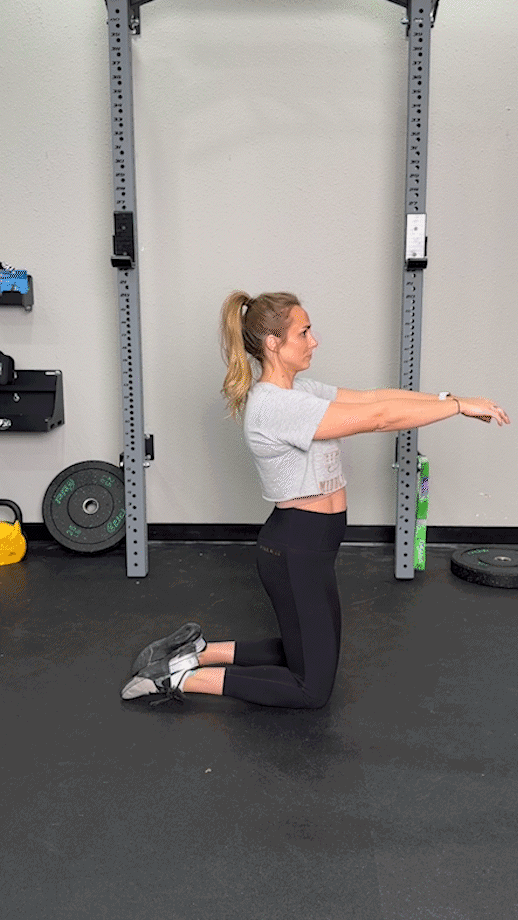Let’s get this dad joke over and done with. Despite its name, there’s nothing sissy about the sissy squat, and it could be the best squat workout you’re not doing. With most squat variations, you squat between your knees and not over your knees. But not so with the sissy squat. For the sissy squat, you’re lifting yourself onto your tiptoes and then driving your knees over your toes as you squat.
The action of driving your knees over your toes makes the sissy squat even more of a quad-dominant exercise. You’ll get a more extensive stretch and larger range of motion on your quadriceps for juicy muscle-building gains on your leg day (or as part of a more dynamic bodyweight leg workout). The best thing about the sissy squat is that all you really need is your own bodyweight, making it one of the best exercises to help strengthen your quads with minimal equipment.
I’ve been a personal trainer for the past 14 years, so I’m here to help you master this squat exercise by getting into all things sissy squat for your quad-building pleasure. Let’s go!
What is a Sissy Squat?
Did you know the sissy squat was named after the mythological Greek king Sisyphus? He must have had some massive quads from all that boulder pushing.
The sissy squat is one of the only bodyweight quad exercises that has you bend and straighten your knees without your hips being involved at all; with the traditional squat, the hip and knee flex equally, but not so here.
The hips are in extension as you squat down and drive your knees over your toes, providing a muscle-building stretch for the rectus femoris, aka the quads. If you’re a beginner to this exercise, it is best to hold on to a squat rack or solid surface for extra stability.
RELATED: Squat Rack Exercises
Sissy Squat: Muscles Worked
Here are the primary muscles worked by the sissy squat.
- Glutes: Although the sissy squat doesn’t directly train the glutes, the glutes are engaged isometrically to keep your hips locked into place.
- Hip flexors (Rectus femoris): The rectus is one of the four quad muscles and the only one that crosses the hips and knee joints. The stretch on the RF and the extensive range of motion that the sissy squat provides help strengthen and mobilize your hip flexors, too. If you’re looking to improve your balance and stability, hip flexor exercises are the way to go.
- Quadriceps: The quads are the prime mover for the sissy squat because the entire exercise is about knee flexion and extension.
- Core: Keeping your spine neutral and torso upright is the key to maintaining balance throughout the sissy squat. This demand falls squarely on your Rectus abdominis, obliques, and lower back to make it work.
How to Do the Sissy Squat
Now that I’ve established the “what?,” let me show you the “how?” Here are my CPT tips on performing the sissy squat with proper form.
- Stand up straight with your feet hip-width or shoulder-width apart and elevate your feet as if performing a calf raise.
- With your glutes engaged, push your knees forward and lean your torso back.
- Once you’ve gone as low as you can with control, or your knees are past your toes, pause, then stand back up, and return to the starting position.
Note: Holding either side of a squat rack or doorframe will give you better stability if required. You can also purchase a sissy squat machine with foot plates or perform them using a Smith machine (see below).

Trainer Tips on Form
Although sissy squats may sound simple enough to perform, they’re far from easy. Here are a few more of my expert tips to keep you on the squat and narrow.
Set Up Based On Your Experience Level
Because of the massive amount of knee flexion you’ll be performing while balancing on your toes, it can be challenging for some to maintain balance during the sissy squat. Holding either side of a door frame or squat rack can help give you extra stability. Holding your arms out in front as you lean back or holding a light weight plate will also act as a counterbalance if you’re more advanced.
RELATED: Balance Exercises
Lean and Drive At the Same Time
Although you’ll initiate the movement with knee flexion, you must bend your knees and lean back simultaneously to avoid losing your balance or hip position.
Keep It Tight
There is minimal hip movement with the sissy squat, and this is only achieved by actively keeping your glutes tight (think top position of the hip thrust workout) and your anterior core engaged.
Benefits of Sissy Squats
There are certainly fancier exercises to build your quads, but you may need extra equipment. The beauty of the sissy squat is that only your body weight is required, making it an exercise you can do anywhere and at any time.

Here are a couple great benefits of the sissy squat.
Become a Quad God
It’s better to be one of the Gods than to be punished by them (sorry, Sisyphus). The primary benefit of the sissy squat is that it’s effective at targeting your quads to build muscle for Olympus-level gains. Removing your hips from the equation puts all the tension on your quads, and combined with the larger range of motion (ROM), go ahead and say yassou to bigger quads.
Better Balance
With or without support, performing the sissy squat can help improve your dynamic balance. Performing this exercise well takes a fair amount of body control, awareness, and patience.
Common Sissy Squat Mistakes
You’ll want to avoid these common sissy squat mistakes so you can get the best out of this bodyweight workout.
Not Locking in Your Glutes and Torso
You’ll need the activation of your core and squeezing of your glutes to keep an upright torso with your hips locked in. Doing so keeps the movement at your knees and nowhere else.
Not Going Knees Over Toes
The nature of the sissy squat exercise is to drive your knees over your toes, and you’ve probably been taught the opposite when it comes to most squat exercises. If you’re unsure or bail out while doing this exercise, just remember that your knees moving past your toes is acceptable in this case. The only thing you should be wary of is whether knee pain exists, and if it does, work within a pain-free range of motion.

Leaning Too Far Back
Leaning the torso back during the sissy squat is all about the torso acting as a counterbalance so you don’t fall. Don’t treat it like a game of limbo; just lean your torso far enough back to balance yourself.
Sissy Squat Variations
Although the bodyweight version is the standard, there are ways to progress or regress the sissy squat according to your experience level.
Smith Machine Sissy Squat
Why do it: The Smith machine variation of the sissy squat has two advantages: the straight fixed range of motion bar gives you more stability, and it allows you to add more load to help you progress.
How to do it:
- Place the Smith machine bar on your upper back with your feet hip-width apart.
- Walk your feet out away from the bar so you are leaning your upper body into it.
- Drive your knees over your toes until you reach your desired depth.
- Pause and return to the starting position.
- Reset and repeat for desired reps.
RELATED: Smith Machine Workouts
Banded Sissy Squat
Why do it: The banded Sissy squat is an excellent alternative to perform if you need a little extra assistance or resistance while building up your balance. Plus, the band takes some of the load off the eccentric contraction, making it a little easier.
How to do it:
- Wrap a resistance band around a squat rack and one leg inside each loop.
- With your feet hip-width apart, get up on your toes.
- Squeeze your glutes, engage your core, drive your knee over your toes, and lean back.
- Stand up to the starting position once you have reached your desired depth.
- Reset and repeat for desired repetitions.
RELATED: Best Resistance Bands for Glutes

Kneeling Sissy Squat
Why do it: The kneeling Sissy squat is a regression of the standing variation and is a perfect place to start if you’re having trouble with the standing variation. Adding a dumbbell or kettlebell here is another great way to progress the movement.
How to do it:
- Begin in the tall kneeling position, with your knees below your hips and on your toes.
- Squeeze your glutes and engage your anterior core.
- Lean back with your glutes towards your heels while keeping your torso straight.
- Once you have reached your desired depth, drive back to the starting position.
- Reset and repeat for desired reps.
Note: The leg press workout, leg extensions, and the hack squat are also great alternatives to train the quads if the sissy squat isn’t working for you.

Sissy Squat: FAQs
What is a sissy squat good for?
The sissy squat is a fantastic leg exercise for strengthening the muscle groups of the quads, hip flexors, and core simultaneously.
Do sissy squats build legs?
Sissy squats are an excellent exercise for adding muscle and building strength in the quads, but could be better for the hamstrings and glutes. Performing other lower body exercises like hip extensions and hamstring exercises like deadlift variations, hip thrusts, and curls may result in better muscle development.
How many sets of sissy squats should I do?
How many sets you should do depends on your goals and level of training experience. As a CPT, I recommend three sets if you’re a beginner and five sets if you’re an advanced trainee.







